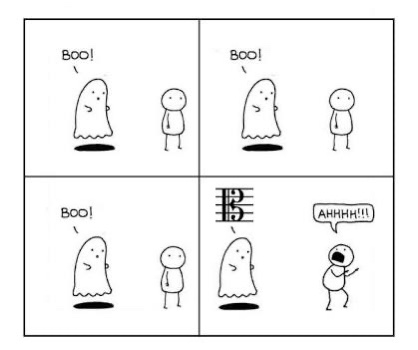Keep up-to-date with the latest news in our Sotto Voce Community!
The Power of Practice: Three Steps to Performance Success
Sunday, June 7, 2020 by Stephanie Jennifer Poropat | Practice

Where should we begin?
The idea of practice can often be daunting and tedious at the best of times – sometimes our only driver being a performance or examination deadline; which, let’s be honest, isn’t the best or most positive motivator from the outset. The academic in me would direct you to Deci & Ryan’s research into the way in which extrinsic motivators actually hinder intrinsic motivation (see: https://selfdeterminationtheory.org/SDT/documents/2000_RyanDeci_SDT.pdf or Deci & Ryan's International Resources Website if interested!).
But for the muggles amongst us who need short, sharp, top-tips for practice, this is the blogpost for you! Here at Sotto Voce, we believe that there are three steps to take in order to set yourself up for practice success.
Step 1: Know Thyself
Without getting too existential on you, the first and most important part of any practice process is to come to terms how YOU learn. Each person has their own individual learning style. This is normal, and it can change over the course of your life. This is why, every now and again, it’s important to check in with yourself and get to know your learning habits, and your goals.
Let’s take a brief glance at some learning styles and see if any of these resonate with you.
Traditionally, it is thought that there are seven learning styles. It is now widely known that there are many more than just seven learning styles and that much research since the 70’s has been done to demonstrate the plethora of ways in in which people can absorb, internalize, and then reproduce information in various contexts to immeasurable ends.
HOWEVER, easing into the subject by just looking at these basic seven is a great way to start.
If you feel your learning style doesn’t fit any of the above categories or if you find yourself in a crossover between a few of the aforementioned, YOU ARE NOT ABNORMAL! We are just looking at the above to give us a foundation. As always, we give you the basics, and it’s then up to you to find out which categories best define how you learn and what strategies to implement to help you grow from there.
The categories are:
Visual or Spatial Learners:
Learner's in this category will prefer using graphics, pictures, images and space in order to learn.
Aural Learners:
Sometimes called Auditory/Musical Learners. People who identify as members of this category tend to learn best when things are put to music or associated with particular sounds.
Verbal/Linguistic Learners:
Here, people prefer using speech or writing in order to absorb information. Basically, verbal learners are all about words in all shapes and forms.
Physical Learning Style:
Also known as a Kinesthetic Learning Style. People who learn this way tend to prefer using their sense of touch, hands, and overall body movement in order to internalize information.
Logical Learning Style:
Sometimes called a Mathematical Learning Style. Here, learners use reasoning and logical systems in a very pragmatic way in order to absorb knowledge or draw conclusions about information presented to them.
Solitary Learning Style:
Sometimes referred to as Intrapersonal Learning Style. These learners prefer to learn and work alone and use self-study techniques in order to achieve their learning goals.
Social Learning Style:
Also known as Interpersonal Learning Style. Social Learners learn best in groups or with other people.
Not sure which category best describes your way of learning? Not to worry! Move on to step two.
Step 2: Help is only a click away
There are so many free websites you can visit which help to determine which learning styles best suit you and how you learn. I’ve listed a few here. Don’t just do one, pick a few and see where you fit in the spectrum.
Something to keep in mind: neuroplasticity and cognitive development are a thing! Basically: don’t be afraid to test yourself again every year or two. Your development as a musician and artist will change both over time, and the way you practice.
- https://www.learning-styles-online.com/inventory/
- http://www.educationplanner.org/students/self-assessments/learning-styles-quiz.shtml
- https://www.how-to-study.com/learning-style-assessment/
- https://vark-learn.com/the-vark-questionnaire/
- http://www.whatismylearningstyle.com/learning-style-test-1.html
- https://www.thoughtco.com/learning-style-quiz-4076781
- https://www.proprofs.com/quiz-school/story.php?title=what-is-my-learning-style
Step 3: Coming up with an Action Plan for Managing Your Precious Practice Time
After all this is said-and-done, it’s important that once you are familiar with how you best internalize information, the next step is to come up with an action plan with the aim being mastery of certain skills. Namely, the practice and performance of your instrument.
Fun Fact: You are more likely to practice if you schedule a regular time each day to practice and stick to it. Even if you aren’t able to practice that day due to illness, but instead engage in “silent practice”.
This might involve a number of things ranging from listening to recordings of your piece and breathing where a particular performer breathes (this may give you new insights into phrasing and interpretation options), to researching more about your piece, it’s composer, it’s context…etc.
The more you know about your piece/it’s composer/context, the better you will be able to translate the information into something effective in performance.
Few things to keep in mind here:
- A warm-up is not practice time. It’s a warm-up. Kind of like how writing notes isn’t studying. It’s writing notes. It’s the necessary precursor to practice. That’s not to say that scales in particular can’t also be part of your practice in the leadup to an exam. However, you need to use your discretion on this.
- It is soooooo important to schedule in regular breaks into your practice time. Especially when singing, as you are dealing with very delicate muscle groups. However, as above, the breaks don’t count as a part of your practice time!
- Be kind to yourself. Yes, it’s important to be driven and to work hard. Hard work will get results. However, burning out doesn’t help you or your audience. Remember: no matter what they tell you (or indeed what we tell ourselves), there will always be another opportunity.
For more tips on time management specifically, our friends at TedEd have a lovely little animation which can help to put things in perspective.
As always, if you have any questions about anything we have discussed here today, please feel free to get in touch with us here on our website, or on any of our socials!


